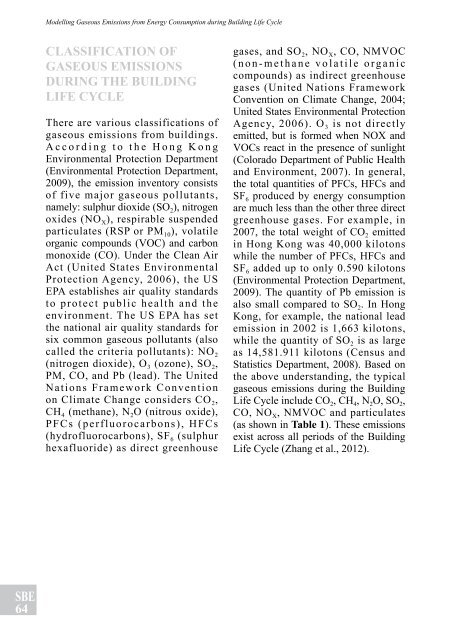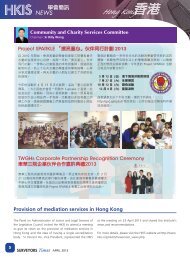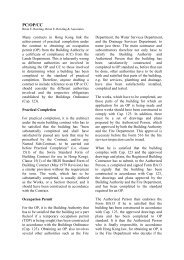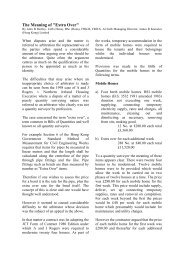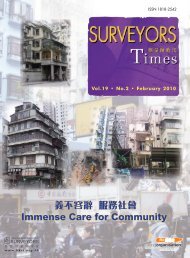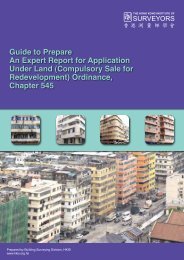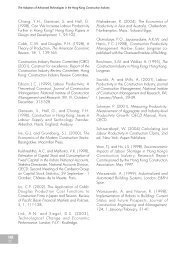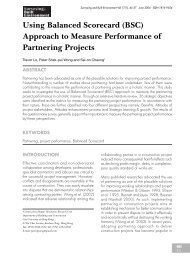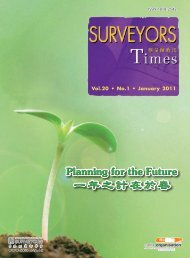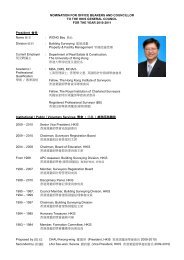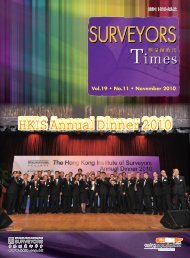Surveying & Built Environment Vol. 22 Issue 1 (December 2012)
Surveying & Built Environment Vol. 22 Issue 1 (December 2012)
Surveying & Built Environment Vol. 22 Issue 1 (December 2012)
Create successful ePaper yourself
Turn your PDF publications into a flip-book with our unique Google optimized e-Paper software.
SBE<br />
64<br />
Modelling Gaseous Emissions from Energy Consumption during Building Life Cycle<br />
ClASSIfICATIoN of<br />
GASEouS EMISSIoNS<br />
duRING THE BuIldING<br />
lIfE CYClE<br />
There are various classifications of<br />
gaseous emissions from buildings.<br />
According to the Hong Kong<br />
<strong>Environment</strong>al Protection Department<br />
(<strong>Environment</strong>al Protection Department,<br />
2009), the emission inventory consists<br />
of five major gaseous pollutants,<br />
namely: sulphur dioxide (SO 2), nitrogen<br />
oxides (NO X), respirable suspended<br />
particulates (RSP or PM 10), volatile<br />
organic compounds (VOC) and carbon<br />
monoxide (CO). Under the Clean Air<br />
Act (United States <strong>Environment</strong>al<br />
Protection Agency, 2006), the US<br />
EPA establishes air quality standards<br />
to protect public health and the<br />
environment. The US EPA has set<br />
the national air quality standards for<br />
six common gaseous pollutants (also<br />
called the criteria pollutants): NO 2<br />
(nitrogen dioxide), O 3 (ozone), SO 2,<br />
PM, CO, and Pb (lead). The United<br />
Nations Framework Convention<br />
on Climate Change considers CO 2,<br />
CH 4 (methane), N 2O (nitrous oxide),<br />
PFCs (perfluorocarbons), HFCs<br />
(hydrofluorocarbons), SF 6 (sulphur<br />
hexafluoride) as direct greenhouse<br />
gases, and SO 2, NO X, CO, NMVOC<br />
(non-methane volatile organic<br />
compounds) as indirect greenhouse<br />
gases (United Nations Framework<br />
Convention on Climate Change, 2004;<br />
United States <strong>Environment</strong>al Protection<br />
Agency, 2006). O 3 is not directly<br />
emitted, but is formed when NOX and<br />
VOCs react in the presence of sunlight<br />
(Colorado Department of Public Health<br />
and <strong>Environment</strong>, 2007). In general,<br />
the total quantities of PFCs, HFCs and<br />
SF 6 produced by energy consumption<br />
are much less than the other three direct<br />
greenhouse gases. For example, in<br />
2007, the total weight of CO 2 emitted<br />
in Hong Kong was 40,000 kilotons<br />
while the number of PFCs, HFCs and<br />
SF 6 added up to only 0.590 kilotons<br />
(<strong>Environment</strong>al Protection Department,<br />
2009). The quantity of Pb emission is<br />
also small compared to SO 2. In Hong<br />
Kong, for example, the national lead<br />
emission in 2002 is 1,663 kilotons,<br />
while the quantity of SO 2 is as large<br />
as 14,581.911 kilotons (Census and<br />
Statistics Department, 2008). Based on<br />
the above understanding, the typical<br />
gaseous emissions during the Building<br />
Life Cycle include CO 2, CH 4, N 2O, SO 2,<br />
CO, NO X, NMVOC and particulates<br />
(as shown in Table 1). These emissions<br />
exist across all periods of the Building<br />
Life Cycle (Zhang et al., <strong>2012</strong>).


